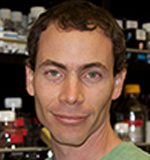
Weizmann Institute of Science, Israel
Dr. Ron Diskin, Principal Investigator at the Weizmann Institute of Science, in Israel, came to EMBL’s cryo-EM service platform for his first cryo-EM project, and instantly became a fan. Diskin and colleagues were trying to solve the structure of the FAS-1 complex of Mycobacterium tuberculosis, which is thought to be the target of a drug that is used to treat tuberculosis (TB). The drug has had a big impact on treatment success, as it halves the notoriously long treatment regimen for tuberculosis – patients typically have to take medication for a year or more – but how it actually works is unclear. Diskin and colleagues want to understand how the drug binds to FAS-1, in order to improve its efficacy or design new drugs that could help to curb multi-drug resistant TB.
Why did you decide to come to EMBL’s cryo-EM service platform?
Well, with the microscopes we have at the Weizmann Institute, we got some preliminary data that was very promising, but it was clear that we needed high-end machines. We started to look for the best options, and decided to apply to iNext. Within iNext, we ended up applying to EMBL Heidelberg because that’s where the waiting time was shortest. In retrospect I don’t think we’d be able to get the same quality of data if we had gone to another facility. Having Wim Hagen to really work with us, to really optimise the way the data was collected – I think that was the major thing that tipped this project to make it successful. The setup that Wim has developed at Heidelberg is quite unique, and it makes a huge difference on the throughput of data collection, which is absolutely critical for a successful project, especially when you’re an outside user who comes for a very limited time.
Were you concerned about only having two days of microscope time?
Yes. You see, FAS-1 is a very big complex, so with the purification strategy that we have and with our ability to create the cryo-EM grids, we have a limitation: the number of particles that we can get per frame. We know roughly the average density of particles in our grids, and based on the number of images that you can acquire according to the specifications of the hardware, we realised that in a typical iNext shift of 48 hours we wouldn’t be able to get enough data. But then we met Wim Hagen, and were introduced to the setup that Wim has developed that really increased the throughput. So that was a good surprise – and it was critical! Eventually we solved this structure with a very limited number of particles, so every particle counted. Every image that we managed to collect was critical.
What makes the setup at EMBL’s cryo-EM service platform unique?
It’s software and hardware tweaks that Wim Hagen has combined. He didn’t develop most of them, but the way he implemented them is quite unique.
Instead of using the software that comes with the microscopes, Wim uses SerialEM, to make it faster. And then by tweaking the microscope he was able to take multiple images per hole, using beam shift – meaning that you don’t need to move the stage, you just move the beam, which is much faster. In other systems people often don’t really like to do that because it introduces some distortions, but Wim was able to tune the microscopes in a way that those distortions will not be significant. So the end result is that you can use beam shift, you can obtain multiple images per hole, and that greatly increases the throughput. Combined with the fast response of the SerialEM software, it makes a huge difference. In other facilities they basically offer the same hardware, but the end result is going to be different just because of those little tweaks that Wim implemented.
And he’s pushing the boundaries all the time! We just had a second session, a year after the first one, and things got much better in terms of data collection. So he’s always improving the setup. And of course he’s doing that so nicely: he’s so friendly, so eager to help; I really appreciate that.
Did you get promising results?
Yes, we were able for the first time to determine the structure of this multi-enzyme complex to high enough resolution to now try the approach to locate the drug bound to the complex. That was a very important milestone. Now, of course, the big question is whether we’ll be able to locate the drug, and it’s still too early to know. But we’ve demonstrated we have the technical capacity to do it.
If a colleague told you they were considering coming to the EMBL cryo-EM service platform, what would you say?
It’s a no-brainer: if there’s a possibility to get scope time in Heidelberg, that would be a better choice than any other microscope in the world today, just because of those little tweaks. And the support is critical. If you have your own microscope, then it becomes less significant. But if you’re coming for a short period of time, then the support that you get on site is absolutely critical, and at EMBL we really got the best support possible.
Would you come back?
If we had the ability to come back next week, we wouldn’t have any doubts, we would have applied already!